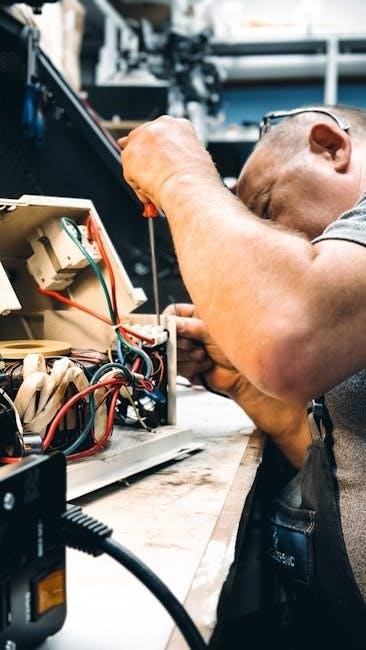
House electrical wiring forms the backbone of modern homes, enabling the safe and efficient operation of electrical devices. Proper wiring ensures power distribution, safety, and future adaptability, while guides like house electrical wiring PDF provide comprehensive resources for learning and execution, making it easier to understand and implement electrical systems effectively.
1.1 Overview of Electrical Wiring Systems
Electrical wiring systems are the backbone of modern homes, enabling the distribution of power to various devices and appliances. These systems consist of cables, switches, outlets, and circuit breakers, designed to ensure safe and efficient energy delivery. Radial and ring wiring are common configurations, each offering unique benefits. Materials like copper cables and PVC insulation are widely used for durability and safety. The system also includes components such as junction boxes and safety devices like RCDs. Proper design and installation are crucial to prevent hazards and ensure reliability. A well-planned electrical wiring system not only powers a home but also adapts to future needs, making it essential for modern living.
1.2 Importance of Proper Electrical Wiring
Proper electrical wiring is crucial for ensuring safety, efficiency, and reliability in a home. It prevents hazards like electrical shocks, fires, and appliance damage, while also guaranteeing consistent power supply. Correct wiring enhances energy efficiency, reducing the risk of overheating and system failures. It also supports future adaptability, allowing for upgrades and new technologies. A well-installed system increases property value and provides peace of mind. Adhering to safety codes and best practices is essential to avoid potential dangers. Proper wiring ensures that all electrical components function optimally, making it a cornerstone of modern living and a critical investment for any homeowner.
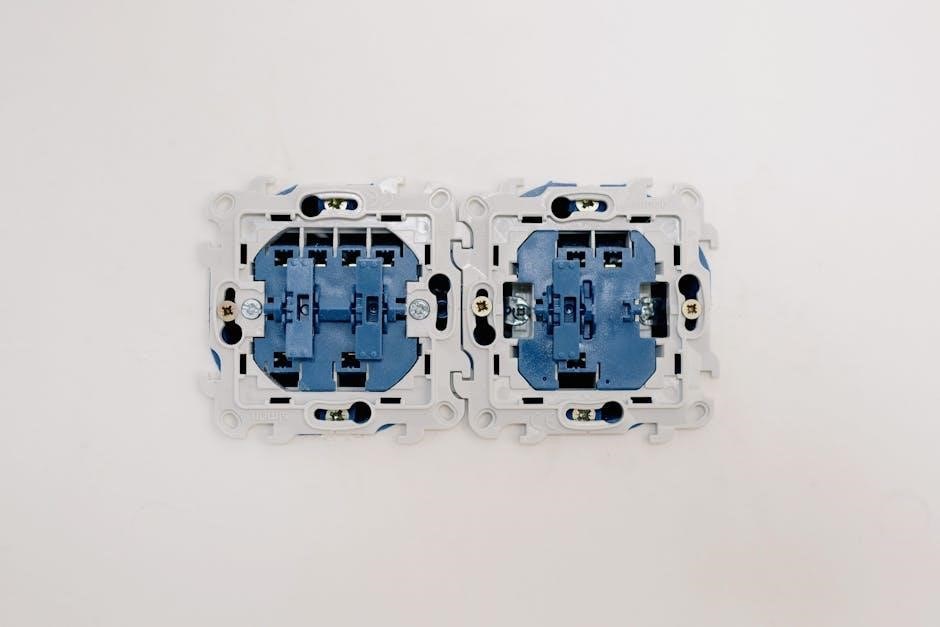
Safety Guidelines for Electrical Wiring
Always turn off power before starting work, use insulated tools, and follow electrical codes to prevent shocks and fires. Ensure safe practices to avoid hazards.
2.1 Understanding Electrical Safety Codes
Electrical safety codes are essential for ensuring safe and compliant wiring practices. The National Electric Code (NEC) and local regulations provide guidelines to prevent hazards like shocks and fires. Key requirements include proper wire sizing, grounding systems, and circuit protection. For example, branch circuits must not mix wire sizes, and receptacles should be no more than 12 feet apart in living areas. These codes also specify safety measures like GFCI protection in wet areas and arc fault protection in bedrooms. Adhering to these standards ensures reliable power distribution and protects people and property from electrical risks. Always consult local codes for specific requirements.
2.2 Precautions for DIY Electrical Work
DIY electrical work requires strict adherence to safety protocols to avoid accidents. Always disconnect power at the circuit breaker or fuse box before starting any project. Use insulated tools and wear protective gear, including gloves and safety glasses. Never touch live wires or components with bare hands. Ensure all circuits are de-energized using a voltage tester before working. Avoid overloading circuits and never bypass safety devices like fuses or circuit breakers. Follow local electrical codes and consult a professional if unsure. Properly label wires and connections for future reference. Test circuits after completion to ensure functionality and safety. Remember, electrical mistakes can lead to shocks, fires, or fatalities, so caution is paramount.

Tools and Materials Needed
Essential tools include wire cutters, strippers, screwdrivers, and pliers. Materials like copper cables, junction boxes, and circuit breakers are crucial for safe and efficient electrical installations.
3.1 Essential Tools for Electrical Wiring
Essential tools for electrical wiring include wire cutters, strippers, screwdrivers, pliers, and voltage testers. These tools enable safe and precise connections. Wire cutters and strippers are used to prepare cables, while screwdrivers and pliers handle connections. Voltage testers ensure circuits are de-energized, preventing shocks. Additionally, drill bits and fish tapes aid in running wires through walls. A multimeter is crucial for diagnosing issues. Proper tools ensure efficiency and safety, reducing risks during installations. Always use high-quality tools to maintain reliability and compliance with safety standards. These tools are fundamental for both professionals and DIY enthusiasts, ensuring successful electrical wiring projects.
3.2 Common Materials Used in House Wiring
Common materials used in house wiring include copper or aluminum wires, PVC insulation, and junction boxes. Copper wires are preferred for their high conductivity and durability. PVC insulation provides protection against electrical shocks and fire hazards. Junction boxes serve as connection points for wires, ensuring safe and organized installations. Additionally, materials like circuit breakers, MCBs (Miniature Circuit Breakers), and RCDs (Residual Current Devices) are essential for safety. Switchboards, distribution boards, and lightning arresters are also key components. These materials ensure reliable power distribution, safety, and compliance with electrical codes. Proper selection of materials is crucial for efficient and secure house wiring systems.
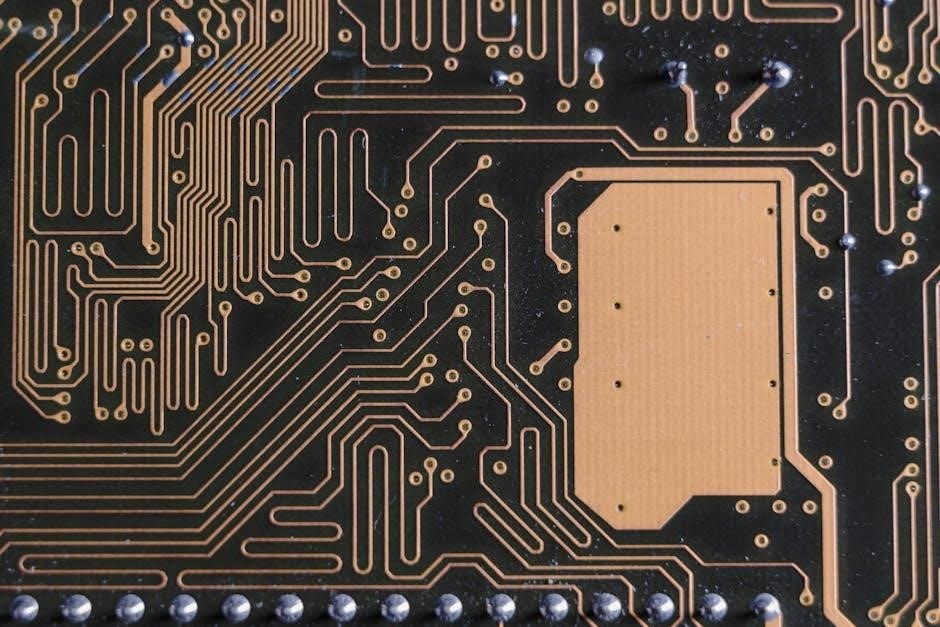
Types of Electrical Wiring Systems
House electrical wiring systems include single-phase for homes, underground wiring using direct burial cables, and circuit configurations ensuring reliable power distribution and safety in various settings.
4.1 Radial Wiring System
The radial wiring system is a common method where a single main cable runs from the distribution board to various points in the house. This system is straightforward and cost-effective, making it ideal for small to medium-sized homes. It involves point-to-point connections, ensuring each outlet or fixture is directly linked to the main supply. This setup simplifies installation and troubleshooting, as faults are easier to identify. However, it may require more materials if multiple outlets are needed. The radial system is widely used in residential settings due to its simplicity, reliability, and ease of maintenance, ensuring safe and efficient power distribution throughout the house.
4.2 Ring Wiring System
The ring wiring system involves a continuous loop of cable that starts and ends at the same point, typically the distribution board. This system is highly efficient, as it evenly distributes power and minimizes cable usage. Each outlet is connected in a circular configuration, ensuring that power is supplied from two directions. This setup offers higher reliability, as a fault in one section doesn’t disrupt the entire circuit. It is commonly used for lighting and power circuits, especially in larger homes. However, the complexity of installation and fault detection can be higher compared to radial systems. Despite this, the ring wiring system remains a popular choice for its balanced power delivery and robust design.
4.3 Lighting and Power Wiring Systems
Lighting and power wiring systems are essential components of a house’s electrical infrastructure. Lighting circuits are designed to power lamps, ceiling fixtures, and outdoor lights, typically operating at lower voltages. Power circuits, on the other hand, supply electricity to high-demand appliances like refrigerators, air conditioners, and washing machines. These systems are usually installed separately to ensure safety and efficiency. Lighting circuits are often connected to switches for easy control, while power circuits require dedicated lines and outlets. Proper installation ensures minimal voltage drop and safe operation. Separating lighting and power wiring also simplifies troubleshooting and enhances overall system flexibility. This dual approach is a cornerstone of modern electrical wiring design.
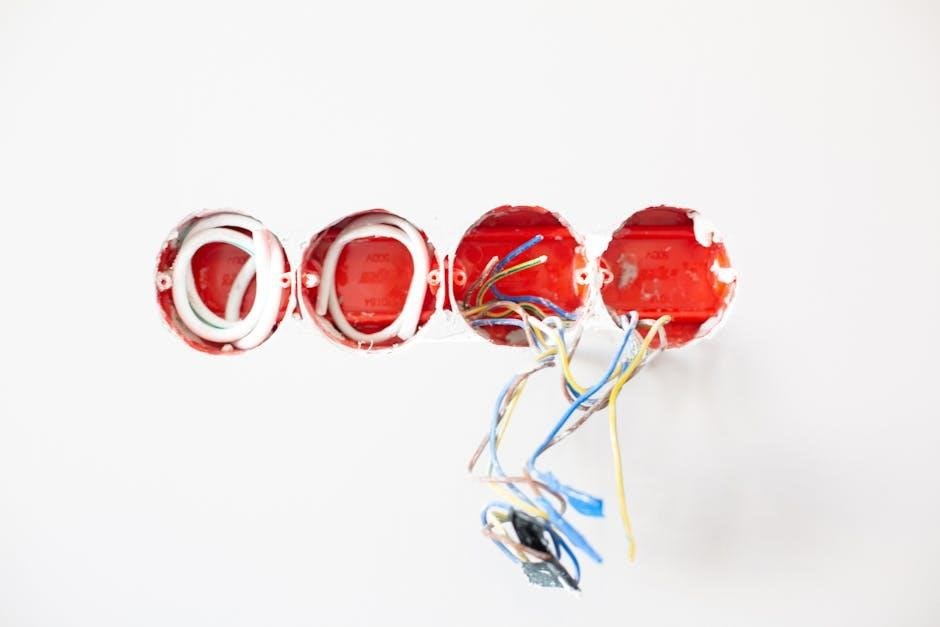
Understanding Electrical Circuits
Electrical circuits distribute power throughout a house, enabling devices to function. They consist of branch and feeder circuits, with junction boxes connecting wires. Understanding circuits ensures safe and efficient electricity flow.
5.1 Branch Circuits and Feeder Circuits
Branch circuits and feeder circuits are essential components of a house electrical system. Branch circuits connect outlets, switches, and appliances to the main electrical panel, ensuring power distribution to specific areas. Feeder circuits, on the other hand, supply power from the main service panel to individual branch circuits or subpanels. Proper design ensures safe and efficient electricity flow. According to the National Electric Code, branch circuits should not mix different wire sizes, and receptacles must be no more than 12 feet apart. Feeder circuits are designed to handle higher currents, connecting multiple branch circuits. Understanding these circuits is crucial for safe and reliable electrical systems in homes.
5.2 Junction Boxes and Their Role
Junction boxes are critical components in house electrical wiring, serving as connection points for wires and electrical devices. They protect wires from environmental damage and ensure safe electrical connections. Junction boxes house switches, outlets, and lighting fixtures, maintaining organization and accessibility. According to safety regulations, they must be installed in accessible locations, not inside walls or hidden spaces. Made from durable materials like plastic or metal, they provide a secure environment for wire splices and connections. Proper installation of junction boxes is essential for compliance with electrical codes and for preventing hazards like short circuits or fires. They play a vital role in maintaining the integrity and safety of a home’s electrical system.

Common Electrical Wiring Issues
Common electrical wiring issues include short circuits, overloaded circuits, faulty connections, and outdated systems. These problems can cause safety hazards, power outages, and equipment damage, requiring prompt attention.
- Short circuits from exposed or damaged wires.
- Overloaded circuits leading to frequent tripping.
- Faulty connections causing intermittent power supply.
- Outdated wiring systems unable to meet modern demands.
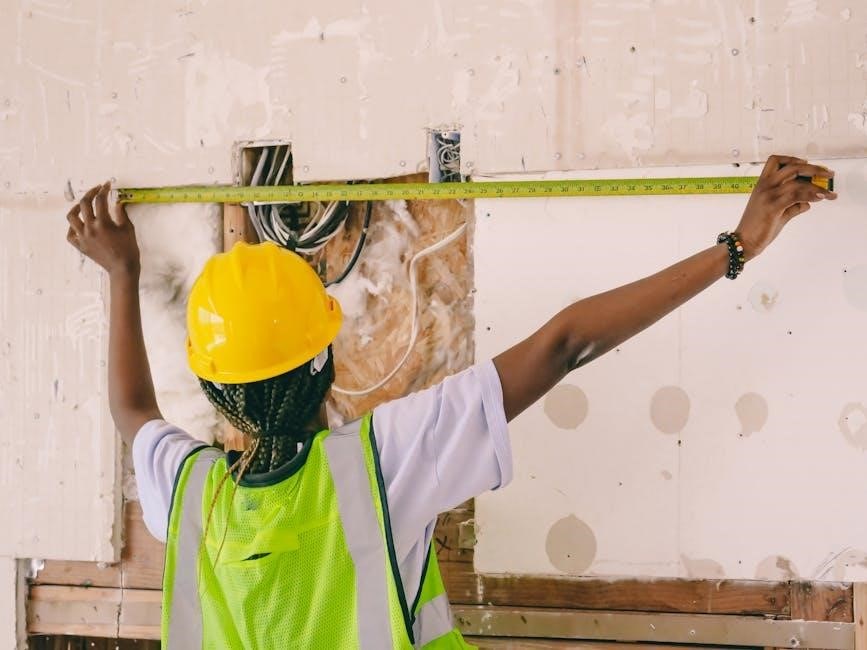
6.1 Identifying Faults in Electrical Wiring
Identifying faults in electrical wiring requires careful observation and testing. Common signs include flickering lights, frequent circuit breaker tripping, and warm or discolored outlets. These issues often indicate short circuits, overloaded circuits, or faulty connections. DIY troubleshooting can start with checking for loose wires or damaged insulation, while professional-grade tools like circuit testers and thermal imaging cameras provide deeper insights. Regular inspections can prevent hazards like electrical fires or equipment damage. Understanding these signs and addressing them promptly ensures safety and reliability in home electrical systems. Always prioritize caution and consider professional assistance for complex or high-risk issues to avoid further complications.
6.2 Troubleshooting Techniques
Troubleshooting electrical wiring involves systematic methods to identify and resolve faults. Start by identifying symptoms like flickering lights or tripped breakers, which can indicate overloaded circuits or short circuits. Use tools such as multimeters to measure voltage and resistance, helping pinpoint issues. Circuit testers can detect faulty outlets or switches, while thermal imaging cameras reveal overheating components. Always turn off power before testing and wear protective gear. Check for loose connections, damaged insulation, or corroded wires. If issues persist, consult a professional. Regular maintenance and inspections can prevent recurring problems. A well-structured approach ensures safety and efficiency in resolving electrical faults, minimizing risks and downtime.

DIY vs Professional Electrical Wiring
Choosing between DIY and professional electrical wiring depends on the project’s complexity. DIY suits minor tasks, while professionals handle complex installations, ensuring safety and compliance with codes.
7.1 When to Hire a Professional Electrician
Hiring a professional electrician is essential for complex tasks like installing new circuits, upgrading electrical panels, or handling high-voltage systems. They ensure compliance with safety codes and regulations, reducing fire and shock risks. DIY projects, such as minor repairs or outlet installations, can be manageable, but professionals are crucial for large-scale or intricate wiring jobs. Their expertise guarantees efficient and safe outcomes, avoiding potential hazards from improper wiring. Additionally, professionals provide warranties and adhere to local electrical codes, ensuring long-term reliability and legal compliance for your home’s electrical system.
7.2 DIY Projects for Home Electrical Wiring
DIY electrical projects can save money and empower homeowners to handle minor wiring tasks. Common projects include installing new outlets, replacing light fixtures, or running low-voltage cables. Guides like the house electrical wiring PDF offer step-by-step instructions for these tasks. However, safety is paramount, and homeowners should always follow electrical codes and precautions. DIY projects are best suited for small, straightforward jobs, while complex systems or high-voltage work require professional expertise. Learning basic wiring skills can enhance home maintenance capabilities, but it’s important to know your limits and seek help when needed to avoid hazards and ensure compliance with safety standards.

Best Practices for Future-Proof Wiring
Plan for future electrical needs by installing scalable systems and energy-efficient designs. Consider upgrading capacity and using high-quality materials to adapt to evolving technology and energy demands.
8.1 Planning for Future Electrical Needs

Planning for future electrical needs involves designing scalable systems to accommodate evolving technology and increased power demands. Consider upgrading wiring capacity and incorporating energy-efficient designs to support smart home devices, electric vehicles, and renewable energy integration. Installing high-quality, flexible materials ensures adaptability for future upgrades. Additionally, consulting with professionals to assess potential electrical requirements helps avoid costly modifications later; This proactive approach ensures your home remains functional and safe as technology advances. Downloadable guides, like the house electrical wiring PDF, provide detailed strategies for future-proofing your electrical system, ensuring it meets both current and future demands efficiently.
8.2 Energy Efficiency in Wiring Design
Energy efficiency in wiring design focuses on minimizing power consumption and reducing energy waste. Using appropriately sized wires and optimizing circuit layouts helps reduce resistance and voltage drop, ensuring efficient energy delivery. Incorporating energy-efficient materials, such as high-quality insulation and low-loss cables, further enhances system performance. Smart home technologies, like automated controls and energy-monitoring systems, can also be integrated to optimize energy use. By prioritizing energy efficiency, homeowners can lower their electricity bills and reduce their environmental impact. Guides like the house electrical wiring PDF provide practical tips and strategies for designing energy-efficient systems that balance performance and sustainability.
Proper house electrical wiring ensures safety, efficiency, and future readiness. Adhering to guidelines and best practices guarantees reliable power distribution and prepares homes for evolving electrical needs.
9.1 Final Tips for Safe and Efficient Wiring
Always adhere to safety codes and use appropriate tools to avoid hazards. Plan wiring systems for future needs, ensuring flexibility and scalability. Regularly inspect circuits and connections to prevent faults. Prioritize energy efficiency by installing smart devices and LED lighting; Consider consulting professionals for complex tasks to ensure compliance and reliability. Keep a wiring diagram handy for easy troubleshooting. Use high-quality materials to minimize risks and prolong system lifespan. Stay informed about updates in electrical codes and best practices to maintain a safe and efficient home electrical system.
